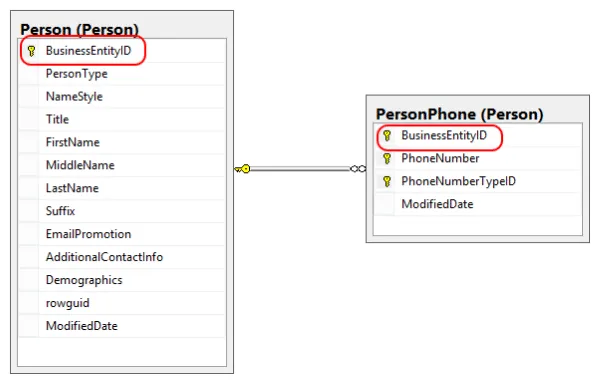In this article we learn the difference between a primary key and a foreign key, and why both are important to maintaining a relational database structure.
All the examples for this lesson are based on Microsoft SQL Server Management Studio and the AdventureWorks2012 database. You can get started using these free tools using my Guide Getting Started Using SQL Server.
What is the Difference between a Primary Key and a Foreign Key?
Before we can dig into the difference, let’s first explore primary and foreign key characteristics. Let’s start out by learning about primary keys.
Primary Keys
In order for a table to qualify as a relational table it must have a primary key.
The primary key consists of one or more columns whose data contained within is used to uniquely identify each row in the table. You can think of them as an address. If the rows in a table were mailboxes, then the primary key would be the listing of street addresses.
When a primary key is composed of multiple columns, the data from each column is used to determine whether a row is unique.
In order to be a primary key, several conditions must hold true. First, as we mentioned, the columns must be unique. To clarify, we’re referring to the data within the rows, not the column names themselves. Also, no value in the columns can be blank or NULL.
When defining a table you specify the primary key. A table has just one primary key, and its definition is mandatory.
The primary key for each table is stored in an index. The index is used to enforce the uniqueness requirement. It also makes it easy for foreign key values to refer back to corresponding primary key values, as we will learn about in the following section.
Foreign Keys
A foreign key is a set of one or more columns in a table that refers to the primary key in another table. There isn’t any special code, configurations, or table definitions you need to place to officially “designate” a foreign key.
In the diagram below look at the SalesOrderHeader table. The column SalesOrderHeader.CurrencyRateID is a foreign key since it is related to the CurrencyRate.CurrencyRateID. This column CurrencyRate.CurrencyRateID is the primary key of the CurrencyRate table.
Foreign Keys as Part of Primaries
Look at the following diagram. Which column is the foreign key?
If you said it was PersonPhone.BusinessEntityID then you are correct. The reason it is a foreign key is that it is referring to a primary key, Person.BusinessEntityID, in the other table.
Coincidentally, PersonPhone.BusinessEntityID is not only a foreign key, but is also part of PersonPhone’s primary key. The PersonPhone table’s primary key is the combination of BusinessEntityID, PhoneNumer, and PhoneNumberTypeID.
I agree this is confusing, but it is allowed and not a bad practice.
Unlike primary keys, foreign keys can contain duplicate values. Also, it is OK for them contain NULL values.
Indexes aren’t automatically created for foreign keys; however, as a DBA, you can define them.
A table is allowed to contain more than one foreign key. In the PersonPhone table can you find the other foreign key (see answer at end of article)?
Finding Primary and Foreign Keys in Object Explorer
When you use SSMS you’ll find all sorts of helpful information in the object explorer. You don’t have to dig deep to find the primary keys. When you show a table’s columns, but clicking on the Columns folder, the primay key columns have gold keys next to them.
Also, if any of the foreign keys are defined in foreign key constraint, which we’ll learn in the following section, then those columns have FK after them. These are circled in green in the above diagram.
Foreign Key Constraints
Some database management systems, such as SQL Server allow you to set up foreign key constraints. These help to enforce referential integrity. In their simplest form, a foreign key constraint stops you from entering values that aren’t found in the related table’s primary key.
Using the first diagram as our example, you can’t enter SalesOrderHeader.CurrencyRateID if it doesn’t already exist in the CurrencyRate table.
These constraints come into effect in several ways:
- They bar you from changing the foreign key value to one which doesn’t exist as a value in the related table’s primary key.
- They stop you from deleting a row from the primary key table. This stops you from creating orphan records. Orphan records are described as “child records with no parents.”
- They stop you from adding a foreign key value that doesn’t exist in the primary key.
In summary, the constraints enforce the relationship between the primary and foreign key tables.
Comparison of Primary Keys to Foreign Keys
To summarize here is a comparison of Primary to Foreign Keys
Answer to Question: Earlier we asked for you to identify the other foreign key in the PersonPhone table. The correct answer is PhoneNumberTypeID.
The post Foreign and Primary Key Differences (Visually Explained) appeared first on Essential SQL.



